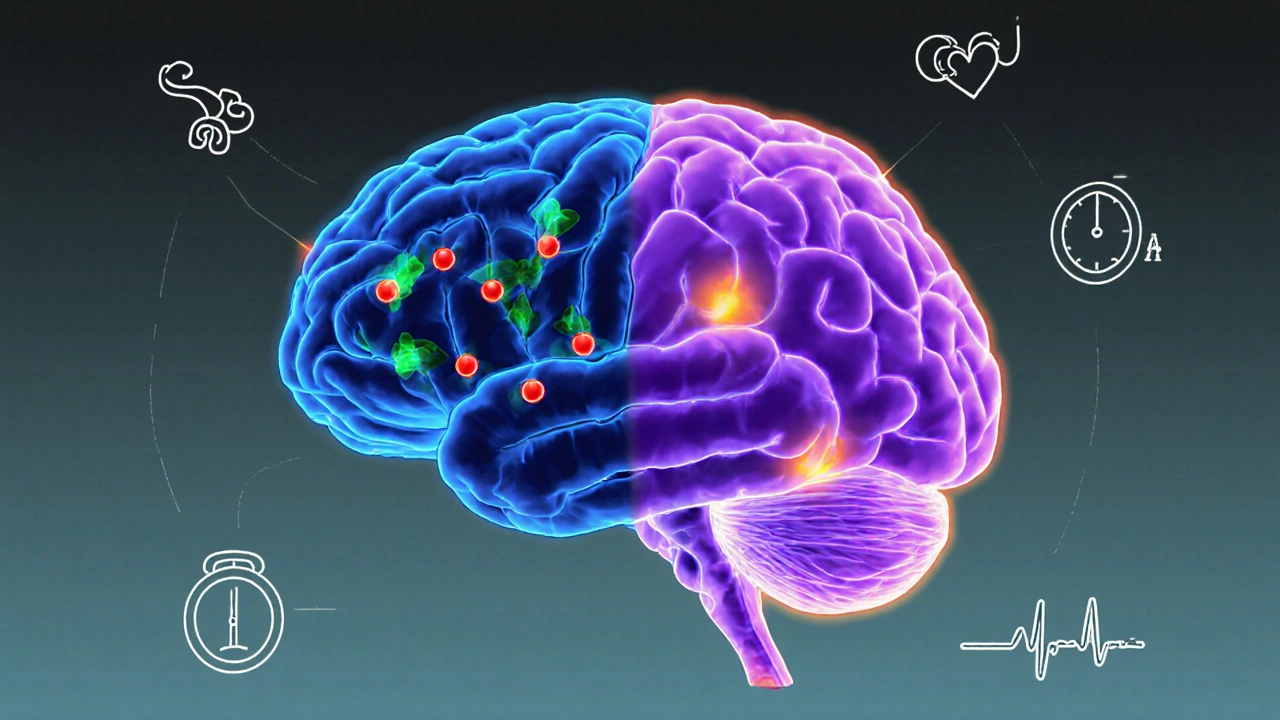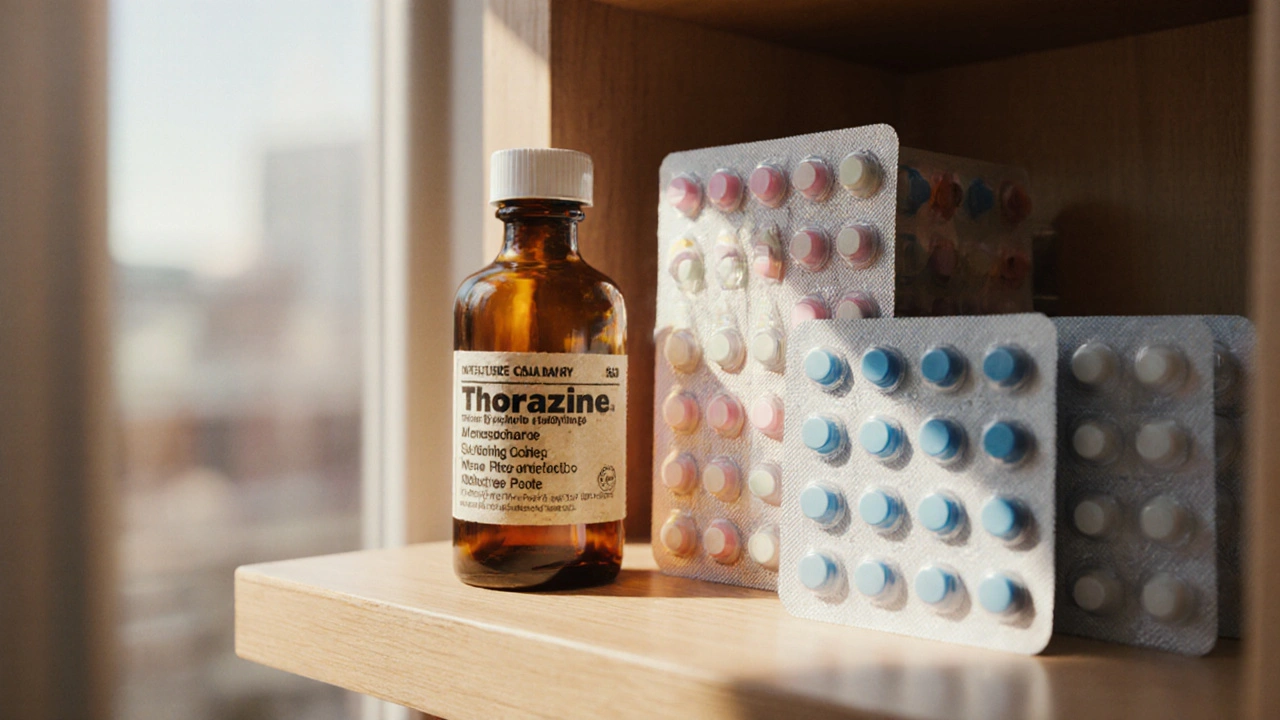Antipsychotic Drug Comparison Tool
Thorazine (Chlorpromazine)
First-generation antipsychotic, effective for severe psychosis but associated with higher extrapyramidal side effects (EPS).
- Blocks dopamine D2 receptors primarily
- Effective for acute psychosis and agitation
- Low cost and widely available
- High risk of EPS, especially at higher doses
- Less sedation compared to other typicals
Side Effect Profile Comparison
| Drug | EPS Risk | Weight Gain | Metabolic Impact | Special Monitoring |
|---|---|---|---|---|
| Thorazine | High | Low-Moderate | Minimal | None required beyond routine labs |
| Haloperidol | High | Low | Minimal | None specific |
| Risperidone | Moderate (dose-dependent) | Low-Moderate | Moderate (prolactin) | Prolactin levels if long-term |
| Olanzapine | Low-Moderate | High | High (glucose, lipids) | Regular metabolic labs |
| Quetiapine | Low | Moderate | Moderate | Blood pressure monitoring |
| Clozapine | Very low | Moderate-High | High | Weekly WBC count for first 6 months |
| Aripiprazole | Low | Low | Low | None beyond routine |
When a doctor prescribes an antipsychotic, the decision often lands on a familiar name like Thorazine. But newer options or different drug classes might fit better for a specific person. This guide breaks down Thorazine (chlorpromazine) side‑by‑side with popular alternatives, highlighting how they work, key benefits, drawbacks, and what to consider when choosing the right medication.
Quick Take
- Thorazine is a first‑generation (typical) antipsychotic that mainly blocks dopamine D2 receptors.
- It’s effective for severe psychosis but often causes movement‑related side effects (EPS).
- Modern atypical drugs (e.g., risperidone, olanzapine) tend to have lower EPS risk but may raise weight or metabolic issues.
- Choosing depends on symptom profile, side‑effect tolerance, and medical history.
- Always discuss dosage, monitoring, and possible drug interactions with a prescriber.
What Is Thorazine (Chlorpromazine)?
Thorazine is a first‑generation antipsychotic (also called a typical antipsychotic) that was introduced in the 1950s. Its generic name, chlorpromazine, belongs to the phenothiazine class and works by blocking dopamine D2 receptors in the brain, reducing psychotic symptoms such as hallucinations and delusions. It’s also used for severe nausea, manic episodes, and certain behavioral issues in children.
How Thorazine Works - The Pharmacology
The drug’s primary action is dopamine antagonism, which dampens the overactive dopaminergic pathways thought to underlie psychosis. It also blocks histamine H1, muscarinic acetylcholine, and alpha‑adrenergic receptors, explaining its sedative and anticholinergic side effects. Typical antipsychotics like Thorazine have a high affinity for D2 receptors but less for serotonin (5‑HT2) receptors, which is why they tend to cause extrapyramidal symptoms (EPS) such as stiffness, tremor, and tardive dyskinesia.
Key Benefits and Drawbacks of Thorazine
- Benefits
- Proven efficacy for acute psychosis and agitation.
- Low cost and widely available in generic form.
- Multiple dosing routes (oral, IM, IV) for flexible administration.
- Drawbacks
- High risk of EPS, especially at higher doses.
- Significant sedation, orthostatic hypotension, and anticholinergic effects (dry mouth, constipation).
- Potential for tardive dyskinesia with long‑term use.

Common Alternatives to Thorazine
Below are the most frequently considered alternatives, grouped by generation and mechanism.
Haloperidol - a typical antipsychotic
Like Thorazine, haloperidol blocks dopamine D2 receptors strongly, but it has a lower affinity for histamine and muscarinic receptors, resulting in less sedation. However, it shares a similar EPS profile and is often chosen for its potent anti‑aggressive effect.
Risperidone - an atypical antipsychotic
Risperidone adds serotonin 5‑HT2A antagonism to dopamine blockade, which reduces EPS risk at moderate doses. It’s effective for schizophrenia, bipolar disorder, and irritability in autism. Weight gain and prolactin elevation are notable side effects.
Olanzapine - an atypical antipsychotic
Olanzapine offers strong dopamine and serotonin antagonism and is favored for its rapid control of psychotic symptoms. The trade‑off is significant weight gain, metabolic syndrome, and sedation.
Quetiapine - an atypical antipsychotic
Quetiapine is less potent at D2 receptors, making it gentler on movement side effects. It’s commonly used for schizophrenia, bipolar depression, and as an off‑label sleep aid. Sedation and orthostatic hypotension are common.
Clozapine - an atypical antipsychotic
Reserved for treatment‑resistant schizophrenia, clozapine has a unique receptor profile that dramatically lowers EPS. However, it requires regular blood monitoring due to risk of agranulocytosis, and it can cause seizures and myocarditis.
Aripiprazole - a dopamine partial agonist
Aripiprazole partially stimulates dopamine receptors while blocking them, which can stabilize mood without strong EPS. It’s often chosen for its lower metabolic side‑effect burden, though activation or akathisia can occur.
Side‑Effect Comparison Table
| Drug | EPS Risk | Weight Gain | Metabolic Impact | Special Monitoring |
|---|---|---|---|---|
| Thorazine | High | Low‑moderate | Minimal | None required beyond routine labs |
| Haloperidol | High | Low | Minimal | None specific |
| Risperidone | Moderate (dose‑dependent) | Low‑moderate | Moderate (prolactin) | Prolactin levels if long‑term |
| Olanzapine | Low‑moderate | High | High (glucose, lipids) | Regular metabolic labs |
| Quetiapine | Low | Moderate | Moderate | Blood pressure monitoring |
| Clozapine | Very low | Moderate‑high | High | Weekly WBC count for first 6months |
| Aripiprazole | Low | Low | Low | None beyond routine |
How to Choose the Right Antipsychotic
Decision‑making can feel overwhelming, but focusing on a few key questions narrows the field:
- What symptom(s) dominate? Severe agitation may justify a high‑potency typical like haloperidol, while mood instability might steer you toward risperidone or aripiprazole.
- How does the patient tolerate movement side effects? If EPS is a major concern, avoid high‑potency typicals and consider atypicals.
- Are metabolic issues a red flag? Patients with diabetes or obesity should steer clear of olanzapine or clozapine without strict monitoring.
- Is regular blood work feasible? Clozapine’s agranulocytosis risk demands weekly labs, which may be impractical for some.
- Cost and insurance coverage? Thorazine and haloperidol are inexpensive; newer atypicals can be pricey, though generics for risperidone and quetiapine are now common.
Working with a psychiatrist to balance these factors usually yields the safest, most effective regimen.
Practical Tips for Switching Medications
- Never stop Thorazine abruptly - taper gradually to avoid withdrawal or rebound psychosis.
- When moving to an atypical, a cross‑taper (overlap for 1‑2 weeks) helps maintain symptom control.
- Monitor for new side effects for the first 4‑6 weeks - EPS, sedation, weight changes, or blood sugar spikes.
- Keep a daily symptom journal; note mood, sleep, and any motor disturbances.
- Schedule a follow‑up appointment within two weeks of any change.
Frequently Asked Questions
Is Thorazine still prescribed in 2025?
Yes, Thorazine remains on formularies worldwide, especially in hospitals for acute psychosis or severe agitation. Its low cost keeps it viable where newer drugs are pricier.
Can I switch from Thorazine to an atypical without side effects?
Switching always carries some risk. A gradual cross‑taper, close monitoring, and a clear symptom diary reduce the chance of rebound psychosis or new side effects.
Which antipsychotic has the lowest risk of weight gain?
Aripiprazole and haloperidol typically cause the least weight increase. However, individual response varies, so regular weight checks are still advised.
Do I need blood tests for Thorazine?
Routine labs (CBC, metabolic panel) are good practice but not required solely for Thorazine. Specific tests may be ordered if you have liver or kidney issues.
What should I do if I develop tremors on Thorazine?
Report the tremor to your prescriber right away. Options include lowering the dose, adding an anticholinergic like benztropine, or switching to an atypical with lower EPS risk.

Bottom Line
Thorazine remains a solid, cost‑effective choice for severe psychosis, but its high EPS profile pushes many clinicians toward newer atypicals when side‑effect tolerance allows. By weighing symptom control, metabolic health, monitoring capacity, and budget, patients and providers can land on the medication that offers the best balance for their unique situation.


12 Comments
I totally get how overwhelming it can feel when you’re weighing Thorazine against the newer atypicals. The high EPS risk is something you really want to keep in mind, especially if the patient already has movement issues. On the other hand, the low price and multiple administration routes make it a solid fallback for acute agitation. It’s also worth noting that the anticholinergic side effects can add up, so monitoring dry mouth and constipation is wise. If metabolic concerns are a priority, Thorazine’s minimal impact there can be a plus. Always have a candid conversation with the prescriber about what side‑effects are tolerable for the individual.
Thanks for laying that out, Selena. When you factor in the pharmacokinetics, Thorazine’s oral bioavailability is decent, but the IM formulation can be a game‑changer in emergency settings. Compared to haloperidol, the sedation profile is actually a bit lighter, which some patients prefer. Keep in mind that dose‑dependent EPS can still surprise you if you push the ceiling too high. It’s a balance between rapid control and tolerability.
yeah i think the cross-taaper is key
otherwise you might get rebound symptoms and that can be scary for the patient
also keep an eye on blood pressure when you switch from a typical to an atypical it can dip
From a historic perspective, Thorazine is not just a drug; it’s a cultural artifact that reshaped modern psychiatry in ways most people overlook. Its introduction in the 1950s was hailed as a miracle, pulling countless souls back from the brink of institutionalization, yet the price we paid in motor side‑effects was a relentless reminder of the trade‑off. In today’s era, where we chase ‘atypical’ labels like fashion statements, dismissing Thorazine as archaic feels almost sacrilegious. The raw potency of its D2 blockade can still dominate an acute psychotic storm faster than many newer agents. However, the tremors, rigidity, and the dreaded tardive dyskinesia loom like shadows at every dose escalation. For clinicians who value cost‑efficiency and proven efficacy in emergency wards, it remains a go‑to. Still, the ethical dilemma of exposing patients to high EPS risk when alternatives exist cannot be ignored. Ultimately, the decision must reflect both the clinical urgency and the patient’s long‑term quality of life.
The data never lies it shows that EPS can cripple a patient’s ability to function and yet we still prescribe it because it’s cheap and familiar the economic pressure is real but patient safety should be paramount we need stricter guidelines and better monitoring maybe a mandatory EPS assessment before dosing
Choosing the right antipsychotic is always a collaborative journey. Consider the individual’s medical history, lifestyle, and what side‑effects they are willing to tolerate. Open communication with the prescribing clinician ensures adjustments can be made early. Remember, many patients thrive on atypicals, but Thorazine still has a place when cost and rapid sedation are priorities.
Switching gradually usually avoids rebound psychosis.
Switching doesn’t have to be scary 😊 a well‑planned cross‑taper over 1‑2 weeks lets the brain adapt while you keep tabs on any emerging side‑effects, and a simple symptom diary can catch issues before they become problematic.
Interesting read, thanks for the breakdown.
From a psychopharmacological standpoint, the risk–benefit calculus of chlorpromazine versus second‑generation agents necessitates a multidimensional assessment framework. First, the dopaminergic antagonism profile of Thorazine yields a high affinity for D2 receptors (Ki ≈ 10 nM), which correlates with a pronounced extrapyramidal symptom (EPS) liability as delineated in the extrapyramidal symptomatology index (ESI). Second, the anticholinergic burden, quantified via the Anticholinergic Cognitive Burden (ACB) scale, positions Thorazine in a moderate‑to‑high tier, potentially exacerbating cognitive deficits in vulnerable cohorts. Third, metabolic parameters remain comparatively neutral; however, longitudinal data reveal a subtle weight trajectory that may become clinically salient over extended treatment horizons. Fourth, the pharmacoeconomic implications cannot be dismissed; generic chlorpromazine offers a cost per defined daily dose that is orders of magnitude lower than branded atypicals, thereby influencing formulary placement decisions. Fifth, the clinician‑patient dyad must appraise adherence propensity, as the sedation profile of Thorazine, though less pronounced than certain low‑potency phenothiazines, still imposes a somnolence risk that may impair daily functioning. Sixth, the regulatory landscape mandates routine laboratory monitoring only for agents with agranulocytosis risk, rendering Thorazine a low‑monitoring burden in contrast to clozapine. Seventh, the therapeutic latency of Thorazine is relatively brisk, achieving symptom amelioration within 24–48 hours in acute agitation scenarios, which is advantageous in emergency department protocols. Eighth, the side‑effect hierarchy underscores the primacy of EPS mitigation strategies, such as prophylactic anticholinergics or dose titration, to forestall tardive dyskinesia onset. Ninth, patient‑reported outcome measures (PROMs) consistently indicate a preference for agents with lower metabolic impact, though EPS remains a deal‑breaker for many. Tenth, the psychosocial context, including stigma associated with “typical” antipsychotics, may influence treatment acceptance and adherence. Eleventh, emerging evidence suggests that pharmacogenomic markers, such as CYP2D6 polymorphisms, modulate chlorpromazine plasma concentrations, necessitating genotype‑guided dosing in precision medicine frameworks. Twelfth, health systems utilizing value‑based purchasing models must incorporate both direct drug costs and downstream expenditures associated with EPS management. Thirteenth, from an ethical perspective, prescribing a high‑EPS drug when a low‑risk alternative is accessible raises concerns regarding non‑maleficence. Fourteenth, interdisciplinary collaboration with pharmacy, nursing, and occupational therapy can optimize monitoring protocols and patient education. Fifteenth, ongoing clinical trials are evaluating novel adjunctive agents to attenuate EPS without compromising antipsychotic efficacy, which may reshape future guidelines. Finally, clinicians should synthesize these multidimensional data points to tailor therapy that aligns with individual patient trajectories, optimizing both clinical outcomes and quality of life.
While the analysis is thorough, the practical realities in many clinics differ. Not every prescriber has access to routine pharmacogenomic testing, nor the time to parse extensive cost‑benefit matrices. Often the decision is driven by immediate availability and insurance formularies. Nonetheless, the emphasis on EPS mitigation remains spot on. A pragmatic approach might involve starting with a low‑dose atypical and reserving Thorazine for rapid tranquilization. Ultimately, aligning the treatment plan with patient preference and systemic constraints is key.
Honestly, most docs just pick the cheapest pill and hope for the best.
Write a comment